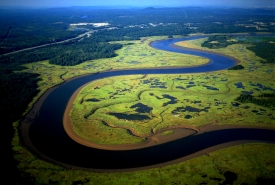14 facts for World Wetlands Day

Musquash River, New Brunswick (Photo by Ron Garnett Airscapes)
The second of February each year marks World Wetlands Day, where everyone is encouraged to raise awareness and learn about the importance and value of wetlands! Be a wetland whiz this year with these 14 fun facts!
A wetland, like its name suggests, is any area of land that is covered with water for a part of the day or year.
Wetlands are among the most biologically diverse and productive of all ecosystems — including rainforests and coral reefs.
Globally, it is estimated that 40 per cent of all wildlife rely on wetlands.
Canada is home to 25 per cent of world’s wetlands. That’s more than any other country.
In Canada, some classes of wetlands include fresh and saltwater marshes, peatlands, swamps, bogs, sloughs and seasonally flooded forests.
Wetlands need our TLC and conservation! Today, estimates say only 28 per cent of southern Ontario’s wetlands remain.
Canada currently has 37 sites designated as Wetlands of International Importance (Ramsar sites).
Like super-sized Brita filters, wetlands have chemical-absorbing, bacteria-neutralizing powers!
Like giant sponges, wetlands hold rain and snowmelt and releases water in drier seasons, reducing risks of floods and droughts.
European common reed (phragmites) is wetlands’ woes! The plant's dense colonies choke out native plants and evict wildlife.
NCC has internationally recognized Ramsar sites in its own backyard! Tabusintac Estuary in New Brunswick is just one example.
Over the next few years, NCC will create a 62-acre (25-hectare) wetland on Pelee Island.
Spawning ground and nursery all in one! Coastal and shallow wetlands alike are a haven for many fish species.
Without wetlands, recreational activities like canoeing, kayaking and birdwatching just aren’t the same.
Want to learn more about the different classifications of wetlands, how they are formed and where they are found? Read all about the wonders of these extraordinary ecosystems on our Wetlands 101 page.
Other fun facts*:
- 16 per cent of Canada is wetland.
- The Long Point marshes in Lake Erie is the largest wetland in southern Ontario.
- The millions of small wetlands of the Canadian and U.S. prairies are the most productive waterfowl habitat in the world, supporting 50 to 88 per cent of the North American breeding populations of several species.
- 80 per cent of wetlands in the Fraser Valley and on the east coast of Vancouver Island are altered or destroyed.
- The Hudson Bay Lowlands is the third-largest wetland in the world.
- Wetlands currently cover between five to 10 per cent of the Earth's land area. It is estimated that more than half of the world's original wetlands have disappeared and they are being lost and degraded more quickly than any other ecosystem type.
*Sources:
Canadian Biodiversity: Ecosystem Status and Trends 2010. Full Report
Biodivcanada, Ecosystems Status and Trends: Wetlands


